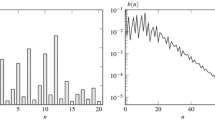Abstract
Using the discrete time approach a model is developed for obtaining the expected queue length of theM(t)/G/1 queue. This type of queue occurs in different forms in transportation and traffic systems and in communications and manufacturing systems. In order to cut down the very high computational efforts required to evaluate the performance measures in such queues by exact methods, the Maximum Entropy Principle is used to approximate the expected queue length which is one of the most commonly used performance measures. A procedure is then developed for reducing the error encountered when this approximation is adopted. The results from this paper will encourage the practitioners to use the appropriate time-varying queueing models when the need arises instead of resorting to very poor approximations.
Similar content being viewed by others
Explore related subjects
Discover the latest articles and news from researchers in related subjects, suggested using machine learning.References
Alfa, A.S.: Approximating queue lengths inM(t)/D/1 queue. Eur. J. Oper. Res.44, 60–66 (1990)
Dafermos, S.C., Neuts, M.F.: A single server queue in discrete time. Cah. Cent. Etud. Rech. Oper.13, 23–40 (1971)
El-Affendi, M.A., Kouvatsos, D.: A maximum entropy analysis of theM/G/1 andG/M/1 queueing systems at equilibrium. Acta Inf.19, 339–335 (1983)
Guiasu, S.: Maximum entropy condition in queueing theory. J Oper. Res. Soc.37, 293–301 (1986)
Jaynes, E.T.: Information theory and statistical mechanics. Phys. Rev.104, 620–630 (1957)
Kouvatsos, D.D.: A maximum entropy analysis of theG/G/1 queue at equilibrium. J. Oper. Res. Soc.39, 183–200 (1988)
Minh, D.L.: The discrete-time single server' queue with time-imhomogenous compound Poisson input. J Appl. Probab.15, 590–601 (1978)
Moore, S.C.: Approximating the behaviour of nonstationary single-server queue. Oper. Res.23, 1011–1032 (1975)
Rego, V., Szpankowski, W.: The presence of exponentiality in entropy maximizedM/GI/1 queues. Comput. Oper. Res.16, 441–449 (1989)
Rothkopf, M.H., Oren, S.S.: A closure approximation for the nonstationaryM/M/s queue. Manag. Sci.25, 522–534 (1979)
Shannon, C.E.: A mathematical theory of communication. Bell Syst. Tech. J.27, 379–423, 623–656 (1948)
Shore, J.E.: Information theoretic approximations forM/G/1 andG/G/1 queuing systems. Acta Inf.17, 43–61 (1982)
Taaffe, M.R., Ong, K.L.: Approximating nonstationaryPh(t)/Ph(t)/1/c queueing systems. Research Memorandum, 85-5, School of Industrial Engineering, Purdue University, West Lafayette, Indiana 47907 (1985)
Wu, J.-S., Chan, W.C.: Maximum entropy analysis of multiple-server queueing systems. J. Oper. Res. Soc.40, 815–825 (1989)
Author information
Authors and Affiliations
Rights and permissions
About this article
Cite this article
Alfa, A.S., Chen, M. Approximating queue lengths inM(t)/G/1 queue using the maximum entropy principle. Acta Informatica 28, 801–815 (1991). https://doi.org/10.1007/BF01261657
Received:
Issue Date:
DOI: https://doi.org/10.1007/BF01261657




